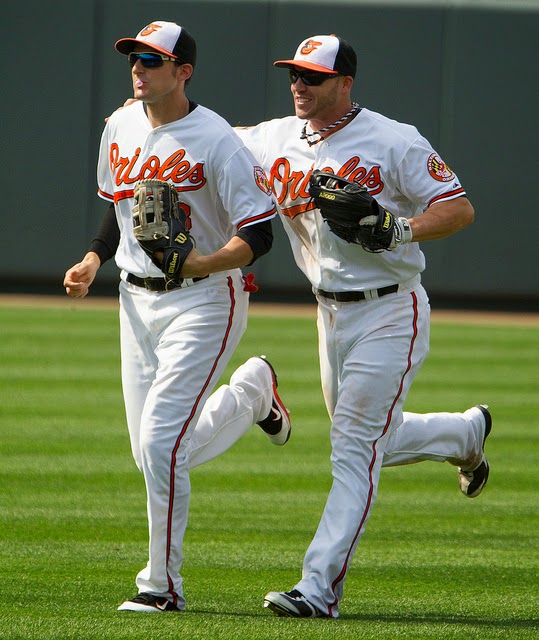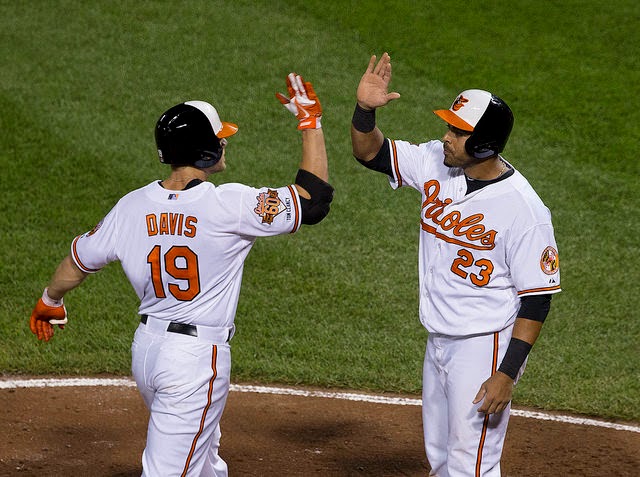If you follow the Orioles at all, then you know Adam Jones chases lots of pitches outside the strikezone. Out of all qualified major leaguers, Jones's 40.3 O-Swing% was eighth highest in 2014. Over the past three years, it is the second highest (41.9%). Unsurprisingly, Jones also swings and misses a lot. He swung and missed at 14.1% of total pitches seen in 2014, tied for eighth in the majors, and over the past three seasons he has whiffed 14.2% of the time (sixth highest).
It's nearly impossible to follow along with an O's game on Twitter without someone discussing Jones's plate discipline. Here's a sampling of things that were said during Game 4 of the American League Championship Series, which happened to be the O's last game of 2014:
Must you have to swing at EVERYTHING Adam Jones??
— JACKSON (@jacksonhillis) October 15, 2014
Adam "Swing at Everything" Jones
— Morgan Conrad (@Iookitsmorgan) October 15, 2014
Is there anything Adam Jones doesn't swing at?
— Jameson Fleming (@JamesonFleming) October 15, 2014
Adam "I swing at everything" Jones better get a hit. He's not clutch at all. Pinch hit for him!
— Chris Harrison (@28chrish) October 15, 2014
There hasn't been a pitch developed that Adam Jones won't swing at.
— Jim May (@RavenMayniac) October 15, 2014
I lose brain cells watching Adam Jones swing at pitches like that
— Orioles Thoughts (@OriolesThoughts) October 15, 2014
You get the point. Most of that is fan frustration. And some is because it's really easy to point out the apparent silliness of a player swinging and missing, especially on a pitch in the dirt or far outside the strikezone. Surely you wouldn't have swung at that obvious ball, right?One of the best things about sports is that various players are able to succeed in different ways. Some players are big; some are small. Some are slow, yet some are fast. In baseball, some players are patient at the plate, and some aren't. Jones's at-bats are rarely works of art. You won't confuse Jones's batting approach with Brett Gardner's or Dustin Pedroia's. When he steps to the plate, Jones is going to swing the bat early and often -- sometimes wildly so.
And guess what? Jones is actually pretty good at what he's doing. Among all qualified MLB center fielders in 2014, Jones was tied for ninth in wOBA (.340). He was tied for eighth in the park-adjusted wRC+ (117). Over the last three years, he's sixth in wOBA (.350) and tied for sixth in wRC+ (121). His 14.1 wins above replacement (fWAR) over the past three seasons, which factors in all his talents on the baseball field, ranks fourth. Baseball-Reference calculates Jones's worth at 12.8 wins over the past three seasons.
Jones's career offensive numbers are not amazing, but they're solid for a center fielder. He's not Mike Trout. He's not Andrew McCutchen. But he's in that next tier of center fielders (or however many tiers there are below Trout), and that's not a bad place to be. His low on-base percentages can be frustrating. But his power numbers cannot be dismissed just because he doesn't draw a bunch of walks.
Many fans seem even more frustrated with Jones in the postseason. He has a career .151/.207/.208 slash line in 13 playoff games. That is truly awful. But that's just 58 plate appearances -- just a couple weeks' worth of trips to the plate. Jones's biggest problem (besides some bad fortune) in the playoffs isn't necessarily his plate discipline -- which is never fantastic -- but that he is facing a higher percentage of quality pitching. Sure, that's true for every hitter in the postseason. But not every good hitter dominates in the postseason, either. In 217 postseason plate appearances, Robinson Cano has a .222/.267/.419 batting line. Josh Hamilton has a .207/.272/.386 line in 162 plate appearances. Those lines are both better than Jones's, but they've also been accumulated over a much larger sample.
The great Eddie Murray once went 25 straight postseason at-bats without reaching base (not counting reaching on an error). That's the second most all time. Murray was very good in the postseason -- .258/.366/.459 in 186 plate appearances -- but imagine the snide comments and hot takes if Twitter had been around during Murray's rotten six-game stretch. (Also interesting: Including reaching on an error, Cano failed to reach base in 24 consecutive at-bats. That's the most all time.)
The postseason is weird. It's a different brand of baseball than regular season ball. Buck Showalter had some interesting comments on that topic the other day:
"If I was going to change the playoff format, I'd make you play seven days in a row, just like during the season," Showalter said. "[Relievers] can't pitch every day. You want to really see the exact same things show up in the postseason? Play seven days in a row instead of all the off-days. We played seven games in 17 days. Something doesn't seem right about that."Perhaps that's just sour grapes, but Showalter seems to be pretty honest. Still, the O's also benefited from the playoff format and were able to use Andrew Miller more often than they normally would. I doubt most fans would complain if playoff baseball was more like regular season baseball, but I doubt any changes are coming on that front.
Adam Jones is a very good player, and he is one of the Orioles' best. If the O's reach the playoffs again sometime in the near future, he'll probably perform better offensively. Really, he can't get much worse. But don't let those 13 disappointing postseason games ruin what Jones is able to accomplish each regular season.
Photo via Keith Allison




.JPG)